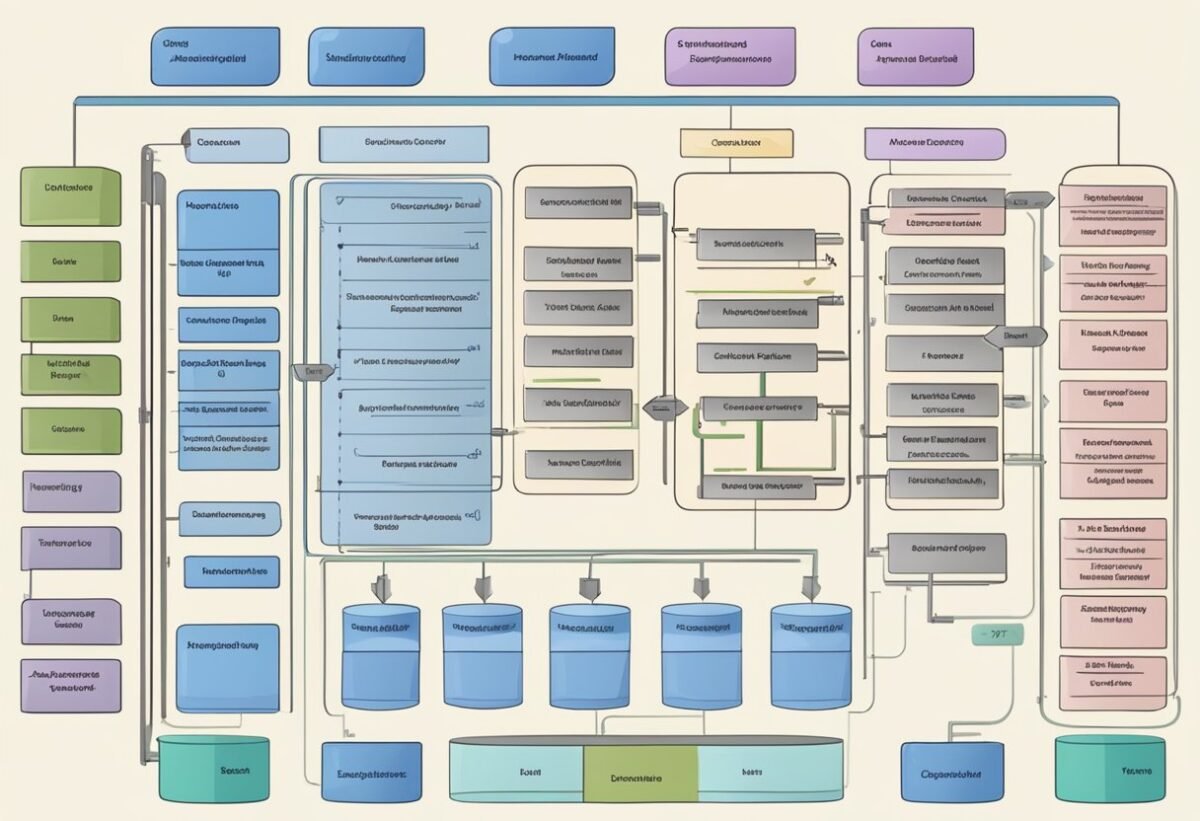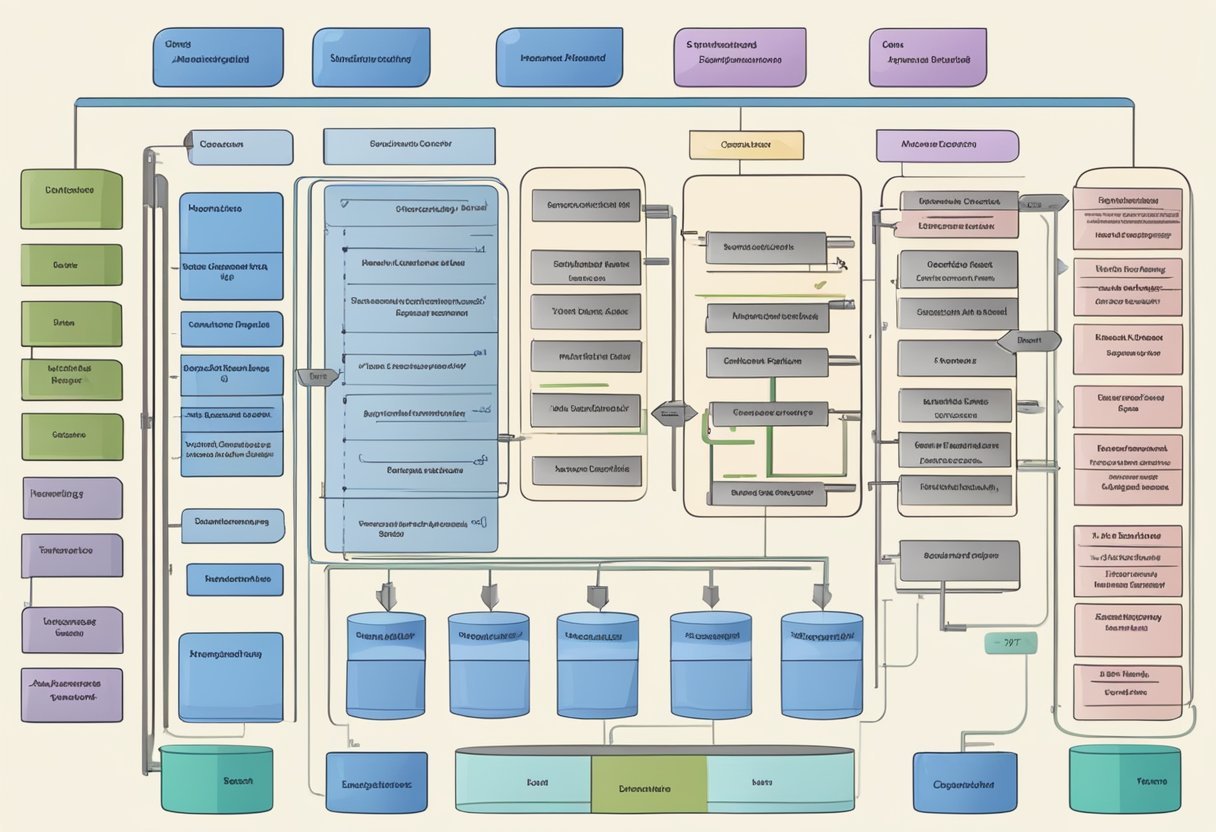Understanding Dynamic Management Views and Functions
Dynamic Management Views (DMVs) and Functions (DMFs) are essential for accessing system information in SQL Server. They offer insights into system performance, health, and configurations, which are valuable for troubleshooting and optimization.
Below, the role of DMVs and DMFs in SQL Server will be explored.
The Role of DMVs and DMFs in SQL Server
DMVs and DMFs provide key data about server health and performance. They are designed to return server state information, allowing administrators to monitor and improve the SQL Server environment.
By querying these views and functions, individuals can track resource usage, query behaviors, and session details.
For example, the sys.dm_exec_cached_plans DMV helps in viewing the query plan cache, providing information on how queries are executed. This can assist in identifying inefficient queries that may need tuning.
Additionally, the sys.dm_exec_sql_text function retrieves the SQL text of cached queries, enhancing understanding of query execution.
These tools are vital for database performance tuning, enabling users to diagnose problems and optimize queries effectively.
Using DMVs and DMFs, administrators gain the power to manage and maintain a healthy database environment.
For further reading on these concepts, see the material on Dynamic T-SQL.
Permissions and Security for DMVs and DMFs
Understanding the permissions and security measures needed for accessing Dynamic Management Views (DMVs) and Dynamic Management Functions (DMFs) is crucial for managing SQL Server environments efficiently. Proper permissions are vital for both accessing data and ensuring security protocols are met.
Necessary Permissions for Accessing System Views
To access DMVs and DMFs, specific permissions are required. Typically, users need the VIEW SERVER STATE permission to access server-level DMVs and DMFs.
This permission allows viewing all the data available through these views, which are vital for analyzing server performance.
For database-specific views, the VIEW DATABASE STATE permission is necessary. This grants access to information pertinent to that particular database.
This permission enables users to see detailed data about database objects, which is crucial for troubleshooting and optimization.
Both permissions are critical for database administrators who analyze and understand server and database operations.
Monitoring and adjusting these permissions regularly is essential to maintain security and functionality.
Security Best Practices
Security is a top priority when working with DMVs and DMFs. Regularly applying security updates is essential to protect against vulnerabilities.
Ensuring only authorized users have access to this data is critical, as these views contain sensitive information about the server and database performance.
Implement strict access controls by assigning permissions to roles rather than individuals. This approach simplifies management and enhances security, as it is easier to audit and enforce policies at a role level.
Regular audits of permission configurations can uncover any unauthorized access attempts and ensure compliance with security policies.
Keeping security measures up-to-date mitigates potential risks, safeguarding data integrity and user privacy.
Exploring Server-State DMVs
Server-State Dynamic Management Views (DMVs) allow users to gain insights into SQL Server’s performance and activity. These views help identify bottlenecks and monitor server resources effectively.
Analyzing Server Performance
Server performance can be assessed using DMVs like sys.dm_os_performance_counters. This view provides metrics on CPU usage, memory, and other key performance indicators.
By examining these metrics, one can understand how well the server is operating.
Another crucial DMV, sys.dm_os_wait_stats, offers insight into wait statistics, highlighting potential delays in query execution. This helps in pinpointing the exact cause of slow performance, whether it’s due to resource contention or inefficient queries.
Analyzing these DMVs regularly aids in maintaining optimal server performance and reducing downtime.
Monitoring Server Activity and Resources
Monitoring server activity requires understanding the current resource usage and workload distribution. DMVs provide information on active connections, sessions, and resource allocation.
This lets administrators track which queries consume the most resources and identify any unusual activity.
Server-state DMVs offer a snapshot view of the server’s operation, allowing for real-time monitoring.
By utilizing this data, administrators can adjust resources or implement changes to improve efficiency.
Navigating Database-State DMVs
Dynamic Management Views (DMVs) provide essential insights into the performance and health of SQL databases. Key areas of focus include maintaining database integrity and assessing the health of database indexes.
Investigating Database Integrity
Database integrity is crucial for reliable data retrieval. To ensure everything works correctly, administrators can use database-scoped DMVs to access detailed information.
These tools assist in identifying potential issues such as data corruption and transaction failures. The sys.dm_db_index_physical_stats view is particularly useful for examining the physical condition and fragmentation of indexes, which can impact data integrity.
By monitoring these views, one can detect irregularities early and perform necessary maintenance to preserve data accuracy. Techniques such as running consistency checks and evaluating warning signals from DMVs are fundamental practices.
Assessing Database Index Health
Indexes play a significant role in query performance by speeding up data retrieval processes. Regularly assessing their health is imperative for maintaining efficiency.
The sys.dm_db_index_physical_stats DMV provides insights on fragmentation levels which affect performance. High fragmentation may lead to slower data retrieval and increased I/O operations.
By analyzing data from this DMV, administrators can decide when to reorganize or rebuild indexes to optimize performance.
Additionally, this view helps track the usage and effectiveness of indexes, guiding decisions about maintaining, modifying, or removing them entirely.
Proper index management ensures robust performance and should be part of routine maintenance.
Execution-Related Dynamic Management Views
Execution-related dynamic management views (DMVs) in SQL Server help in managing and optimizing queries. They provide insights into current execution requests and statistics, which are vital for performance tuning and troubleshooting.
Tracking Execution Requests
Tracking execution requests can be effectively done using the sys.dm_exec_requests DMV. This view gives detailed information about every request currently being executed on SQL Server.
It includes columns like session_id, wait_type, and command, which help in monitoring active queries. These details assist in identifying performance bottlenecks or potential deadlocks.
Using this view, administrators can monitor long-running queries and ensure efficient resource usage.
By accessing such detailed execution data, they can promptly address issues that may arise during query execution.
Examining Execution Statistics
Understanding performance requires examining execution statistics through DMVs like sys.dm_exec_query_stats. This view provides data on query execution count, total elapsed time, and logical reads.
Such statistics are crucial for identifying resource-intensive queries that may degrade server performance.
Sys.dm_exec_sql_text can be used alongside sys.dm_exec_query_stats to retrieve the SQL text of the executed queries.
By analyzing this data, administrators can fine-tune queries, ensure efficient indexing, and improve overall system performance.
These views enable a comprehensive analysis of execution patterns, promoting proactive database management and optimization efforts.
Index-Related Dynamic Management Views
Index-related Dynamic Management Views (DMVs) in SQL Server provide insights into how indexes are used and their impact on performance. These views allow database administrators to monitor index efficiency and make informed decisions for optimization.
Index Usage and Performance Analysis
Dynamic Management Views related to index usage offer valuable insights into how indexes are being utilized within the database.
For instance, by using views like sys.dm_db_index_usage_stats, database administrators can track how often indexes are accessed through various operations. This helps in identifying whether certain indexes are underused or overburdened, which can inform decisions on whether to keep, modify, or remove an index.
Performance analysis using these DMVs can reveal potential improvements.
For example, the sys.dm_db_index_operational_stats view provides real-time statistics on index performance, such as locking and waiting times.
This information is crucial for diagnosing performance bottlenecks and ensuring that indexes contribute positively to the server’s efficiency.
These index-related insights are essential for maintaining a balanced and high-performing SQL Server environment, ensuring that database operations run smoothly and efficiently.
For more detailed descriptions of index-related DMVs, readers can refer to resources like Much Ado About Indexes available online.
I/O-Related Dynamic Management Views
I/O-related dynamic management views (DMVs) help in diagnosing and monitoring database performance. These views give insight into disk usage, which can be crucial for identifying bottlenecks and improving SQL server operations.
Identifying I/O Bottlenecks and Issues
I/O bottlenecks often arise from excessive read and write operations. Identifying these issues is key to maintaining an efficient database.
Dynamic management views such as sys.dm_io_virtual_file_stats provide vital statistics on file operations, helping users spot potential bottlenecks.
Monitoring views like sys.dm_io_pending_io_requests can further track pending I/O operations. This data helps pinpoint delays in the system.
By evaluating these views, database administrators can make informed decisions to optimize performance and allocate resources effectively.
Understanding these metrics is essential for anyone involved in SQL server management.
Using DMVs for Performance Tuning
Dynamic Management Views (DMVs) play a crucial role in SQL Server performance tuning. They provide insights into database activity and help diagnose problems by showing where resources are being used.
This section covers strategies for improving query performance and analyzing wait statistics.
Strategies for Query Performance Improvement
DMVs offer valuable data for enhancing query performance. By examining these views, one can identify inefficient queries.
Important DMVs like sys.dm_exec_query_stats offer insights into query execution times and resource use. Another useful view, sys.dm_exec_requests, helps in understanding ongoing requests and their resource consumption.
Index usage is another vital aspect. DMVs like sys.dm_db_index_usage_stats shed light on which indexes are being actively used. This assists in deciding whether to create new indexes or remove unused ones, improving efficiency.
Buffer management can also be optimized using DMVs. The sys.dm_os_buffer_descriptors view shows data pages in the buffer pool, which can help in tuning resource allocation and ensuring efficient memory use.
Analyzing Wait Statistics for Tuning
Wait statistics are key to diagnosing bottlenecks. DMVs offer detailed views on waits with sys.dm_os_wait_stats. This view provides insight into the types of waits occurring in the system and their durations.
High wait times can indicate where processes are getting delayed. Locks and latches are common issues that appear here.
By analyzing sys.dm_tran_locks, users can see active lock requests that may be blocking queries.
For a more specific diagnosis, one can look at the running tasks. Through sys.dm_exec_requests, one can identify queries waiting for resources.
Understanding these waits allows for strategic adjustments and resource reallocation, effectively boosting performance.
Integrating DMVs with Other Tools
Integrating Dynamic Management Views (DMVs) with various tools can enhance the monitoring and optimization of SQL Server performance.
Linking DMVs with Performance Monitor helps in tracking SQL Server activities and metrics. By using DMVs, administrators can extract detailed performance data. For instance, dynamic management views can monitor queries and resource consumption.
Performance Monitor provides a graphical interface to view this data in real time. By linking these tools, users can identify slow-running queries or high resource usage. This integration offers essential insights, helping to diagnose issues quickly and make data-driven adjustments.
For effective integration, it is important to select relevant counters in Performance Monitor. This can include SQL Server locks, buffer cache, and indexing, which, when paired with DMVs, provide a comprehensive view of server health.
Linking with Performance Monitor
Linking DMVs with Performance Monitor helps in tracking SQL Server activities and metrics.
By using DMVs, administrators can extract detailed performance data. For instance, dynamic management views can monitor queries and resource consumption.
Performance Monitor provides a graphical interface to view this data in real time. By linking these tools, users can identify slow-running queries or high resource usage. This integration offers essential insights, helping to diagnose issues quickly and make data-driven adjustments.
For effective integration, it is important to select relevant counters in Performance Monitor. This can include SQL Server locks, buffer cache, and indexing, which, when paired with DMVs, provide a comprehensive view of server health.
Ad Hoc Query Optimization
Optimizing ad hoc queries is crucial for maintaining efficient SQL Server operations. Dynamic Management Functions give insight into how these queries are processed and executed.
For instance, DMVs can help identify inefficient ad hoc queries by analyzing execution plans and resource usage. Once problematic queries are identified, developers can rewrite them for better performance.
Techniques such as parameterization and indexing are often employed to achieve more stable and efficient query execution.
Effective query optimization involves continuous monitoring and adjustments. Utilizing DMVs ensures that temporary table usage, query plans, and indexing strategies align with best practices for ad hoc queries. This maintains server performance and reduces resource wastage, enhancing overall system efficiency.
Best Practices for Querying DMVs and DMFs
Efficient querying of Dynamic Management Views (DMVs) and Dynamic Management Functions (DMFs) is crucial for optimizing SQL Server performance. This involves careful consideration of the columns selected and writing efficient queries to reduce resource usage and enhance performance.
When querying DMVs and DMFs, it’s more efficient to select individual columns rather than using SELECT *. Selecting only the necessary columns reduces the amount of data processed and returned, improving query performance. This approach minimizes resource usage, allowing the server to perform other tasks more efficiently.
Selecting specific columns also makes it easier to understand and maintain the query. By including only relevant data, queries become more readable, which is crucial for debugging and optimization. This practice is particularly important in complex databases with large tables and numerous columns, where fetching all data could lead to unnecessary overhead.
Selecting Individual Columns vs Select *
When querying DMVs and DMFs, it’s more efficient to select individual columns rather than using SELECT *.
Selecting only the necessary columns reduces the amount of data processed and returned, improving query performance. This approach minimizes resource usage, allowing the server to perform other tasks more efficiently.
Selecting specific columns also makes it easier to understand and maintain the query. By including only relevant data, queries become more readable, which is crucial for debugging and optimization. This practice is particularly important in complex databases with large tables and numerous columns, where fetching all data could lead to unnecessary overhead.
Tips for Writing Efficient DMV Queries
Writing efficient queries for DMVs and DMFs involves several key practices.
One method is ensuring that filters, such as WHERE clauses, are used to limit the data processed. This helps in reducing execution time and resource consumption.
Indexes on columns can also enhance performance, enabling faster data retrieval.
When dealing with complex queries, breaking them down into smaller, simpler parts can improve efficiency and readability. This involves writing sub-queries that focus on specific tasks.
Using built-in SQL functions can further optimize query performance by performing operations directly on the SQL Server, reducing the need for additional processing in application code.
Updates and Version-Specific Considerations
It is essential to understand how new features in SQL Server versions can be used to enhance T-SQL capabilities. A focus is also on maintaining compatibility with older versions like SQL Server 2005 to ensure seamless database operations.
New SQL Server versions often introduce features that optimize and extend T-SQL functionality. These updates include enhancements in dynamic management views (DMVs) and functions, which provide improved insights and control over database operations.
For instance, the sys.dm_server_services DMV is a newer feature that allows users to see detailed information about service processes. This capability can lead to better performance tuning and troubleshooting.
Constantly updating T-SQL scripts to incorporate these latest features ensures that database systems remain robust and efficient. It is key for users to stay informed about updates in each version to take full advantage.
Backward compatibility plays a crucial role in many organizations that still use older systems. It allows newer T-SQL scripts to run on SQL Server 2005, enabling gradual transitions to more recent software without immediate disruptions.
To maintain compatibility, developers must be cautious about using non-supported features in older SQL Server environments. This might mean avoiding specific DMVs or functions that do not exist in SQL Server 2005.
Understanding the differences between SQL Server versions aids in writing adaptable and flexible T-SQL code. Compatibility ensures smooth database operations with minimal risk of errors or data losses. This careful approach is critical for maintaining reliable and consistent database systems.
Resources and Support for SQL Server DMVs
SQL Server offers various resources and support options for learning about Dynamic Management Views (DMVs). These include access to Microsoft technical support and numerous documentation resources to help users effectively manage and troubleshoot SQL databases.
Microsoft offers robust technical support for SQL Server users, providing assistance for issues related to DMVs. Users can access support through various channels such as Microsoft Edge with integrated support features.
Technical support includes personalized help through phone or chat, depending on the user’s subscription. This can be especially useful for resolving complex problems quickly. Feedback from users is encouraged to improve services and support quality. Additionally, forums and community supports are accessible, providing a platform for sharing knowledge and solutions.
There are numerous additional resources available for users who want to learn more about DMVs.
Official Microsoft documentation provides detailed guidance on using DMVs and T-SQL functions. These documents often include step-by-step tutorials and examples.
For more in-depth learning, users can access books and online courses focused on DMVs and SQL Server performance tuning. Blogs and articles by SQL experts also offer practical insights and tips. These resources are invaluable for those looking to optimize their database management skills.
Frequently Asked Questions
Dynamic management views (DMVs) are crucial for monitoring and optimizing SQL Server performance. They offer insights into system health and help in integrating data analytics tools. Understanding different scopes and roles within DMVs enhances their usage.
How can dynamic management views be used for performance tuning in SQL Server?
Dynamic management views provide real-time data on SQL Server operations. By analyzing execution statistics and cache usage, they help in identifying bottlenecks, optimizing queries, and improving overall performance. For instance, the sys.dm_exec_query_stats view can be used to find long-running and resource-intensive queries.
What is the difference between server-scoped and database-scoped dynamic management views?
Server-scoped DMVs provide information about the entire SQL Server instance, while database-scoped DMVs are limited to a specific database. Server-scoped views are essential for system-wide diagnostics, whereas database-scoped views focus on particular database performance and management tasks.
Which dynamic management views are essential for monitoring server performance?
Key DMVs for monitoring server performance include sys.dm_exec_requests for tracking executing requests, sys.dm_exec_sessions for session information, and sys.dm_exec_query_plan for accessing execution plans. These views help administrators maintain optimal server health by providing critical data on processes and resource usage.
How do dynamic management views integrate with Power BI for data analytics?
DMVs can be queried to extract performance data directly into Power BI. This integration allows for the creation of interactive dashboards and reports that visualize SQL Server metrics, making it easier to analyze and present database performance data effectively.
What are the key considerations when working with dynamic management views in Azure Synapse Analytics?
When using DMVs in Azure Synapse Analytics, considerations include understanding Synapse-specific DMVs and their outputs, security permissions, and the impact on performance. Because of the scale of operations in Synapse, selecting relevant DMVs and interpreting their data correctly is crucial for effective monitoring and optimization.
What is the role of sys.dm_tran_active_transactions in transaction monitoring?
The sys.dm_tran_active_transactions view provides details on active transactions within SQL Server. It includes information such as transaction start time and state. This view is crucial for monitoring transaction performance. It also helps in resolving issues related to locking, blocking, or long-running transactions.


















